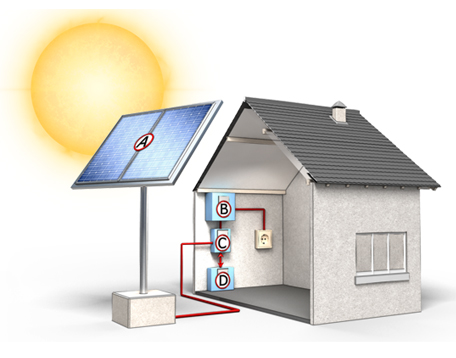- Solar technology
- >> Photovoltaics
- >> Installation types
In a permanent relationship – the grid-connected unit
The most simple and most economical way of using the electricity from a photovoltaic installation is through a grid-connected system. The direct current generated by the modules is transformed by the inverter into 230 V alternating current and fed entirely into the public grid. The energy needed for the house is then purchased as before from the selected energy provider.Depending on the type of module, inverter combination, location and angle of incidence, a 1.0 KWp unit in Germany will generate between 650 and 1,150 kWh electricity a year. Through the reimbursement for the electricity fed in to the grid, plus the depreciation benefits and possible additional subsidies, you not only generate truly clean electricity you also get your investment back again over the course of the years, and then actually make a profit.
Main components of grid-connected units:
1. PV generator (several PV modules connected in parallel rows with assembly frame)
A: PV module
B: inverter
C: input meter
D: output meter
These self-supporting units (sometimes described as "autarkic" in technical circles) are primarily found on objects that do not have any access to electricity from the mains, e.g. on camping sites or summer houses in gardens. In such cases, the operator's prime objective is to have his or her own power source. With the aid of storage batteries, insular solutions offer the possibility of being independent of the mains. Because of the instant reimbursement for the electricity fed into the system, which is currently much higher than the normal purchase price, however, there is little point in storing the generated energy and using it when needed. An insular installation of this kind is therefore really only worthwhile for objects that are not connected to the public power grid.
|




